battery MERCEDES-BENZ CL600 2000 W140 Owner's Guide
[x] Cancel search | Manufacturer: MERCEDES-BENZ, Model Year: 2000, Model line: CL600, Model: MERCEDES-BENZ CL600 2000 W140Pages: 424, PDF Size: 25.71 MB
Page 355 of 424
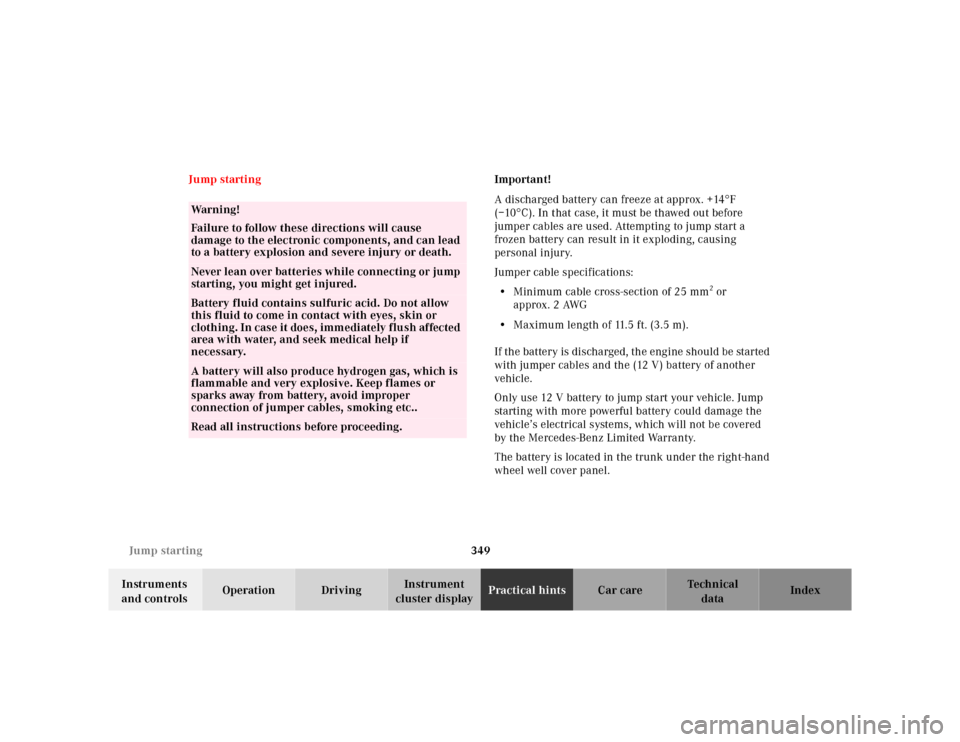
349 Jump starting
Te ch n ica l
data Instruments
and controlsOperation DrivingInstrument
cluster displayPractical hintsCar care Index Jump startingImportant!
A discharged battery can freeze at approx. +14°F
(–10°C). In that case, it must be thawed out before
jumper cables are used. Attempting to jump start a
frozen battery can result in it exploding, causing
personal injury.
Jumper cable specifications:
•Minimum cable cross-section of 25 mm
2 or
approx. 2 AWG
•Maximum length of 11.5 ft. (3.5 m).
If the battery is discharged, the engine should be started
with jumper cables and the (12 V) battery of another
vehicle.
Only use 12 V battery to jump start your vehicle. Jump
starting with more powerful battery could damage the
vehicle’s electrical systems, which will not be covered
by the Mercedes-Benz Limited Warranty.
The battery is located in the trunk under the right-hand
wheel well cover panel.
Wa r n i n g !
Failure to follow these directions will cause
damage to the electronic components, and can lead
to a battery explosion and severe injury or death.Never lean over batteries while connecting or jump
starting, you might get injured.Battery fluid contains sulfuric acid. Do not allow
this fluid to come in contact with eyes, skin or
clothing. In case it does, immediately flush affected
area with water, and seek medical help if
necessary.A battery will also produce hydrogen gas, which is
flammable and very explosive. Keep flames or
sparks away from battery, avoid improper
connection of jumper cables, smoking etc..Read all instructions before proceeding.
Page 356 of 424
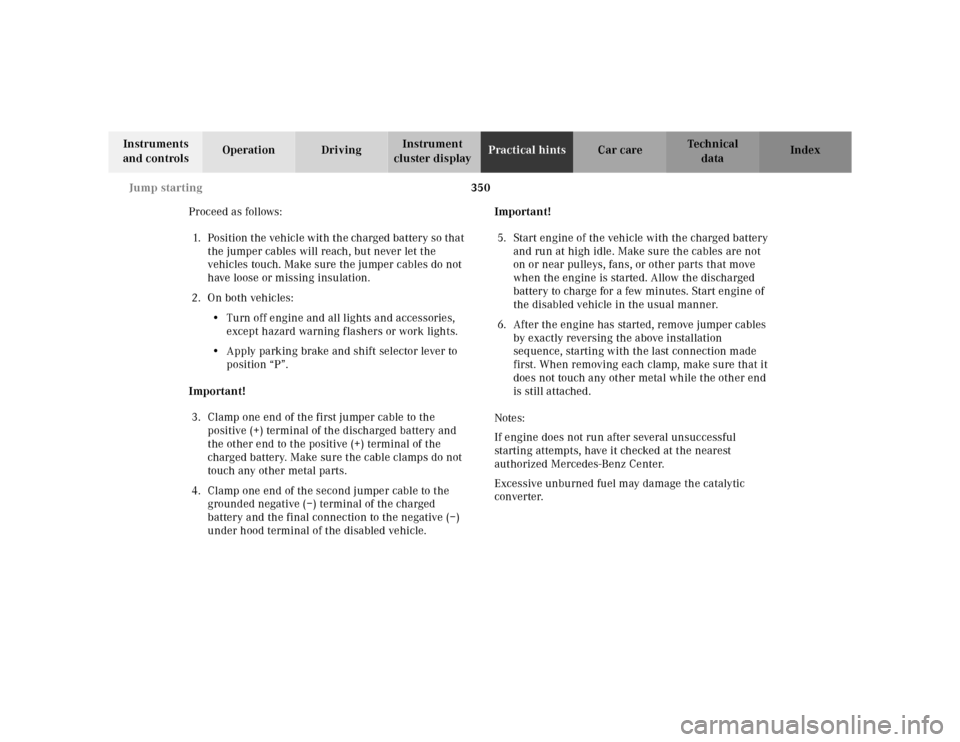
350 Jump starting
Te ch n ica l
data Instruments
and controlsOperation DrivingInstrument
cluster displayPractical hintsCar care Index
Proceed as follows:
1. Position the vehicle with the charged battery so that
the jumper cables will reach, but never let the
vehicles touch. Make sure the jumper cables do not
have loose or missing insulation.
2. On both vehicles:
•Turn off engine and all lights and accessories,
except hazard warning flashers or work lights.
•Apply parking brake and shift selector lever to
position “P”.
Important!
3. Clamp one end of the first jumper cable to the
positive (+) terminal of the discharged battery and
the other end to the positive (+) terminal of the
charged battery. Make sure the cable clamps do not
touch any other metal parts.
4. Clamp one end of the second jumper cable to the
grounded negative (–) terminal of the charged
battery and the final connection to the negative (–)
under hood terminal of the disabled vehicle.Important!
5. Start engine of the vehicle with the charged battery
and run at high idle. Make sure the cables are not
on or near pulleys, fans, or other parts that move
when the engine is started. Allow the discharged
battery to charge for a few minutes. Start engine of
the disabled vehicle in the usual manner.
6. After the engine has started, remove jumper cables
by exactly reversing the above installation
sequence, starting with the last connection made
first. When removing each clamp, make sure that it
does not touch any other metal while the other end
is still attached.
Notes:
If engine does not run after several unsuccessful
starting attempts, have it checked at the nearest
authorized Mercedes-Benz Center.
Excessive unburned fuel may damage the catalytic
converter.
Page 357 of 424
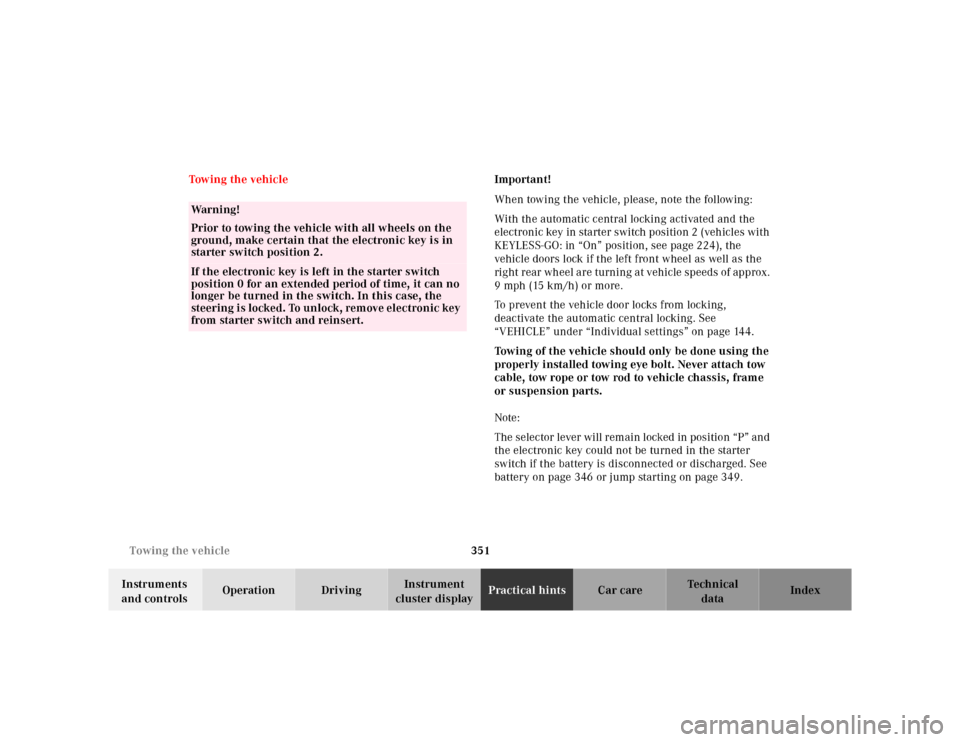
351 Towing the vehicle
Te ch n ica l
data Instruments
and controlsOperation DrivingInstrument
cluster displayPractical hintsCar care Index Towing the vehicleImportant!
When towing the vehicle, please, note the following:
With the automatic central locking activated and the
electronic key in starter switch position 2 (vehicles with
KEYLESS-GO: in “On” position, see page 224), the
vehicle doors lock if the left front wheel as well as the
right rear wheel are turning at vehicle speeds of approx.
9 mph (15 km/h) or more.
To prevent the vehicle door locks from locking,
deactivate the automatic central locking. See
“VEHICLE” under “Individual settings” on page 144.
Towing of the vehicle should only be done using the
properly installed towing eye bolt. Never attach tow
cable, tow rope or tow rod to vehicle chassis, frame
or suspension parts.
Note:
The selector lever will remain locked in position “P” and
the electronic key could not be turned in the starter
switch if the battery is disconnected or discharged. See
battery on page 346 or jump starting on page 349.
Wa r n i n g !
Prior to towing the vehicle with all wheels on the
ground, make certain that the electronic key is in
starter switch position 2.If the electronic key is left in the starter switch
position 0 for an extended period of time, it can no
longer be turned in the switch. In this case, the
steering is locked. To unlock, remove electronic key
from starter switch and reinsert.
Page 369 of 424
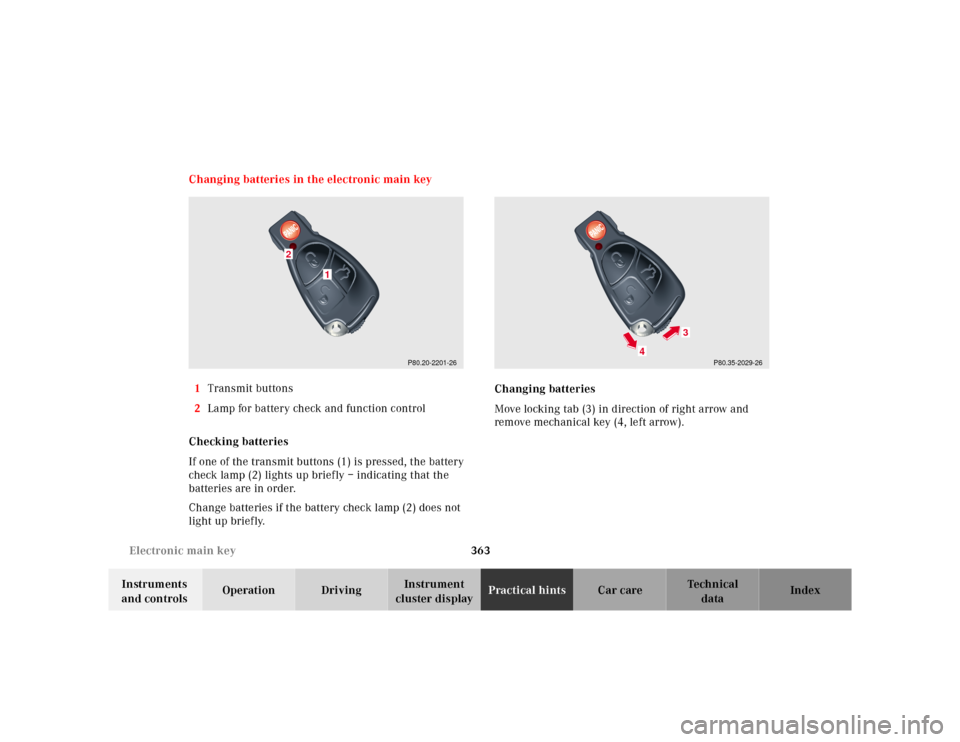
363 Electronic main key
Te ch n ica l
data Instruments
and controlsOperation DrivingInstrument
cluster displayPractical hintsCar care Index Changing batteries in the electronic main key
1Transmit buttons
2Lamp for battery check and function control
Checking batteries
If one of the transmit buttons (1) is pressed, the battery
check lamp (2) lights up briefly – indicating that the
batteries are in order.
Change batteries if the battery check lamp (2) does not
light up briefly.Changing batteries
Move locking tab (3) in direction of right arrow and
remove mechanical key (4, left arrow).
P80.20-2201-26
1
2
P80.35-2029-26
4
3
Page 370 of 424
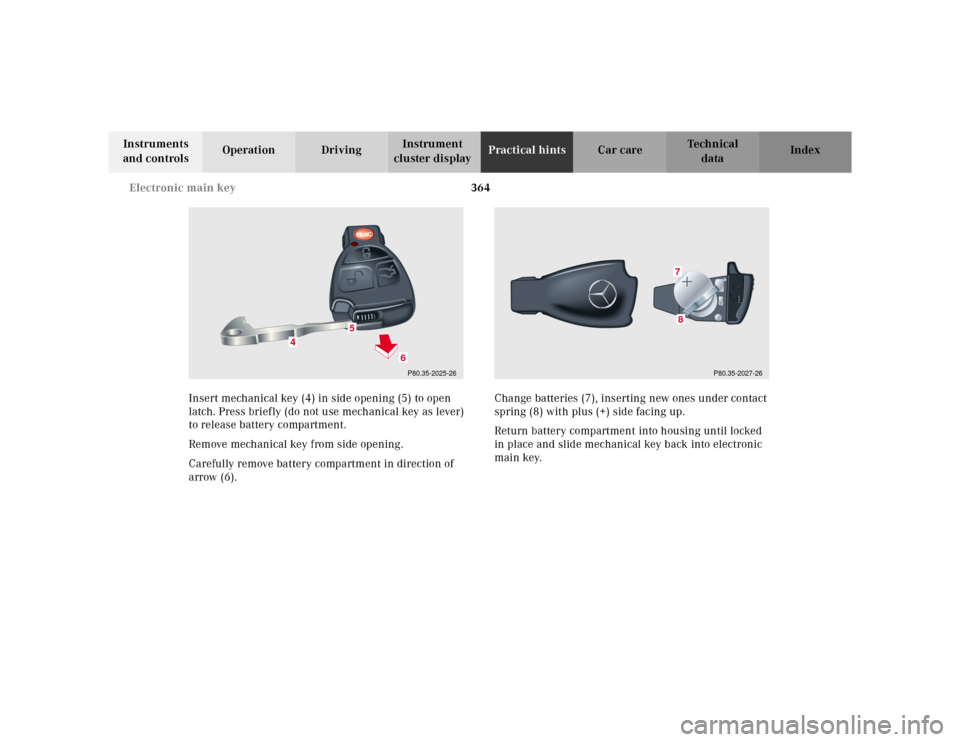
364 Electronic main key
Te ch n ica l
data Instruments
and controlsOperation DrivingInstrument
cluster displayPractical hintsCar care Index
Insert mechanical key (4) in side opening (5) to open
latch. Press briefly (do not use mechanical key as lever)
to release battery compartment.
Remove mechanical key from side opening.
Carefully remove battery compartment in direction of
arrow (6).Change batteries (7), inserting new ones under contact
spring (8) with plus (+) side facing up.
Return battery compartment into housing until locked
in place and slide mechanical key back into electronic
main key.
P80.35-2025-26
5
4
6
P80.35-2027-26
78
Page 371 of 424
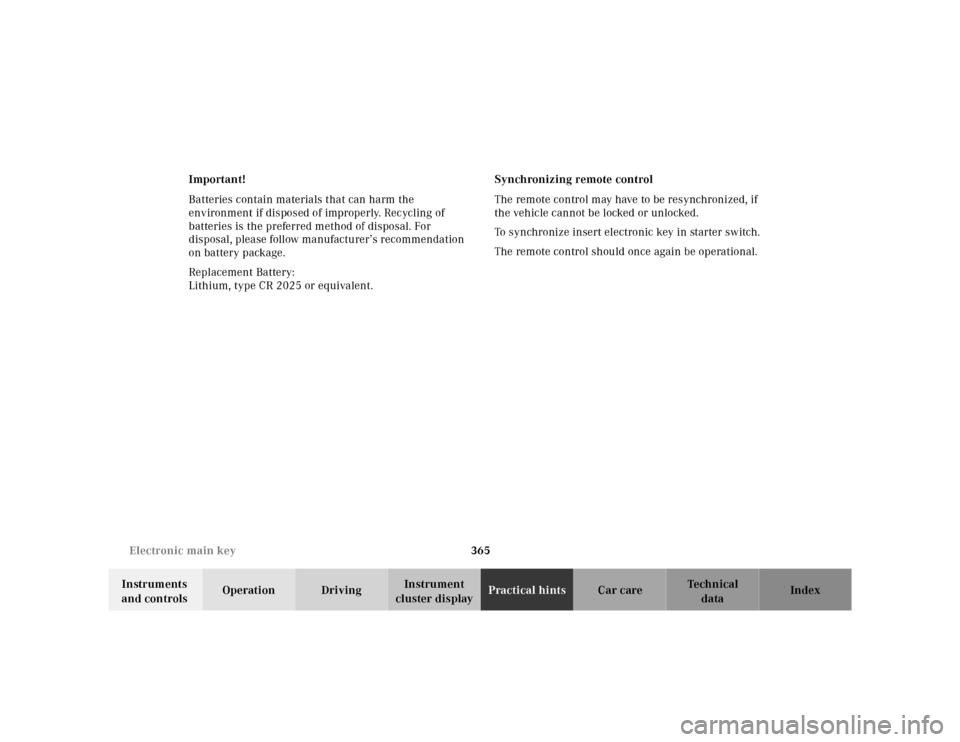
365 Electronic main key
Te ch n ica l
data Instruments
and controlsOperation DrivingInstrument
cluster displayPractical hintsCar care Index Important!
Batteries contain materials that can harm the
environment if disposed of improperly. Recycling of
batteries is the preferred method of disposal. For
disposal, please follow manufacturer’s recommendation
on battery package.
Replacement Battery:
Lithium, type CR 2025 or equivalent.Synchronizing remote control
The remote control may have to be resynchronized, if
the vehicle cannot be locked or unlocked.
To synchronize insert electronic key in starter switch.
The remote control should once again be operational.
Page 373 of 424
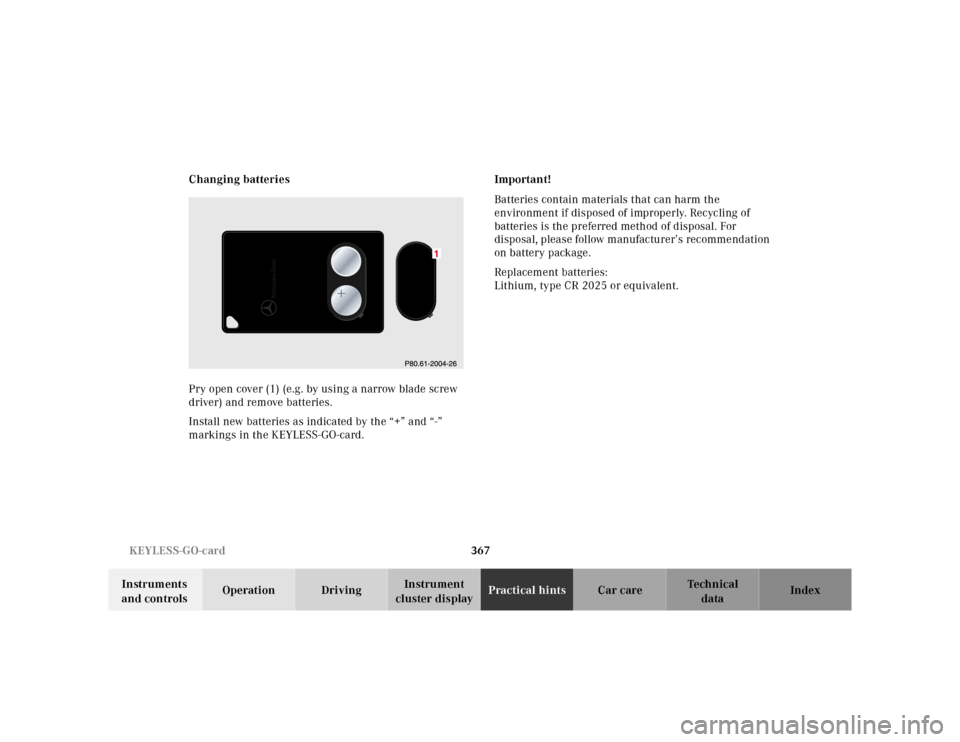
367 KEYLESS-GO-card
Te ch n ica l
data Instruments
and controlsOperation DrivingInstrument
cluster displayPractical hintsCar care Index Changing batteries
Pry open cover (1) (e.g. by using a narrow blade screw
driver) and remove batteries.
Install new batteries as indicated by the “+” and “-”
markings in the KEYLESS-GO-card.Important!
Batteries contain materials that can harm the
environment if disposed of improperly. Recycling of
batteries is the preferred method of disposal. For
disposal, please follow manufacturer’s recommendation
on battery package.
Replacement batteries:
Lithium, type CR 2025 or equivalent.
Page 374 of 424
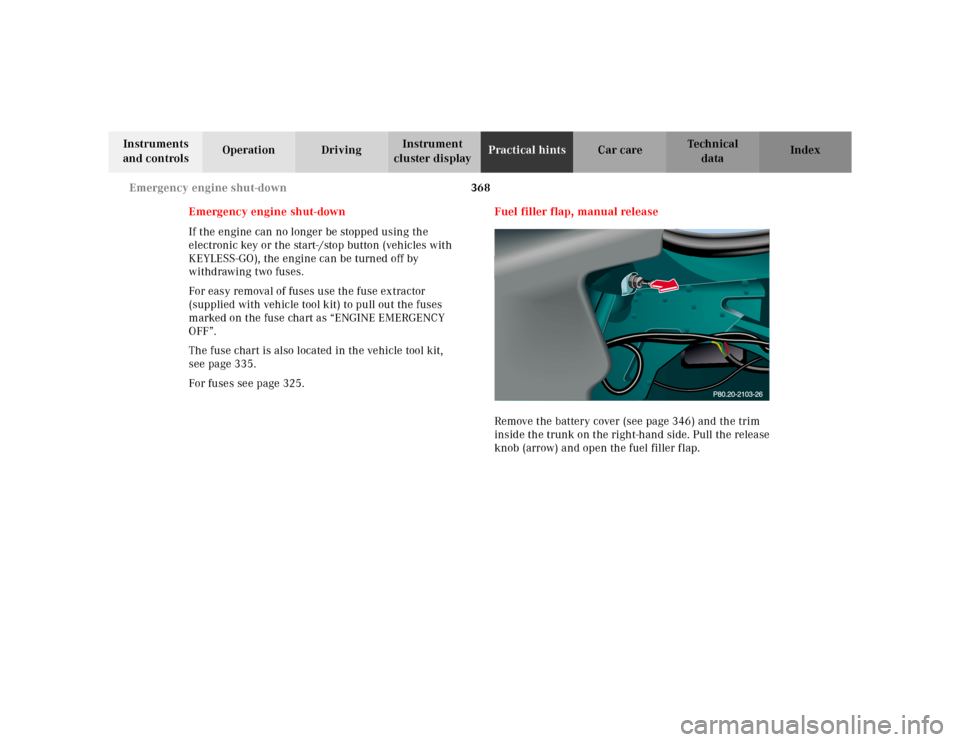
368 Emergency engine shut-down
Te ch n ica l
data Instruments
and controlsOperation DrivingInstrument
cluster displayPractical hintsCar care Index
Emergency engine shut-down
If the engine can no longer be stopped using the
electronic key or the start-/stop button (vehicles with
KEYLESS-GO), the engine can be turned off by
withdrawing two fuses.
For easy removal of fuses use the fuse extractor
(supplied with vehicle tool kit) to pull out the fuses
marked on the fuse chart as “ENGINE EMERGENCY
OFF”.
The fuse chart is also located in the vehicle tool kit,
see page 335.
For fuses see page 325.Fuel filler flap, manual release
Remove the battery cover (see page 346) and the trim
inside the trunk on the right-hand side. Pull the release
knob (arrow) and open the fuel filler flap.
Page 397 of 424
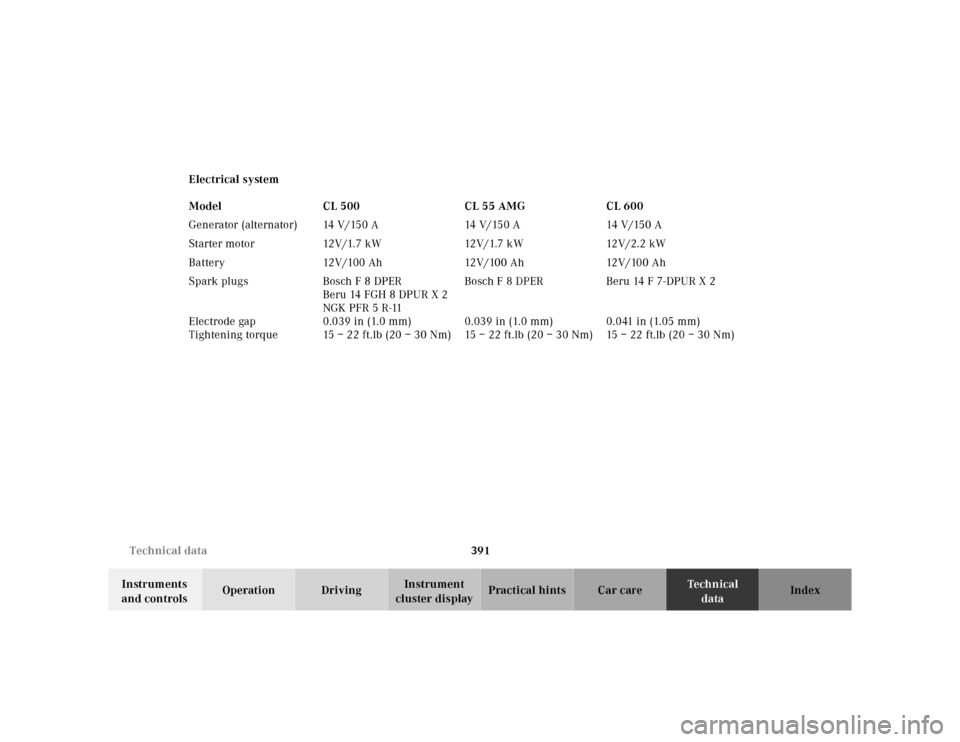
391 Technical data
Te ch n ica l
data Instruments
and controlsOperation DrivingInstrument
cluster displayPractical hints Car care Index Electrical system
Model CL 500 CL 55 AMG CL 600
Generator (alternator) 14 V/150 A 14 V/150 A 14 V/150 A
Starter motor 12V/1.7 kW 12V/1.7 kW 12V/2.2 kW
Battery 12V/100 Ah 12V/100 Ah 12V/100 Ah
Spark plugs
Electrode gap
Tightening torqueBosch F 8 DPER
Beru 14 FGH 8 DPUR X 2
NGK PFR 5 R-11
0.039 in (1.0 mm)
15 – 22 ft.lb (20 – 30 Nm)Bosch F 8 DPER
0.039 in (1.0 mm)
15 – 22 ft.lb (20 – 30 Nm)Beru 14 F 7-DPUR X 2
0.041 in (1.05 mm)
15 – 22 ft.lb (20 – 30 Nm)
Page 408 of 424
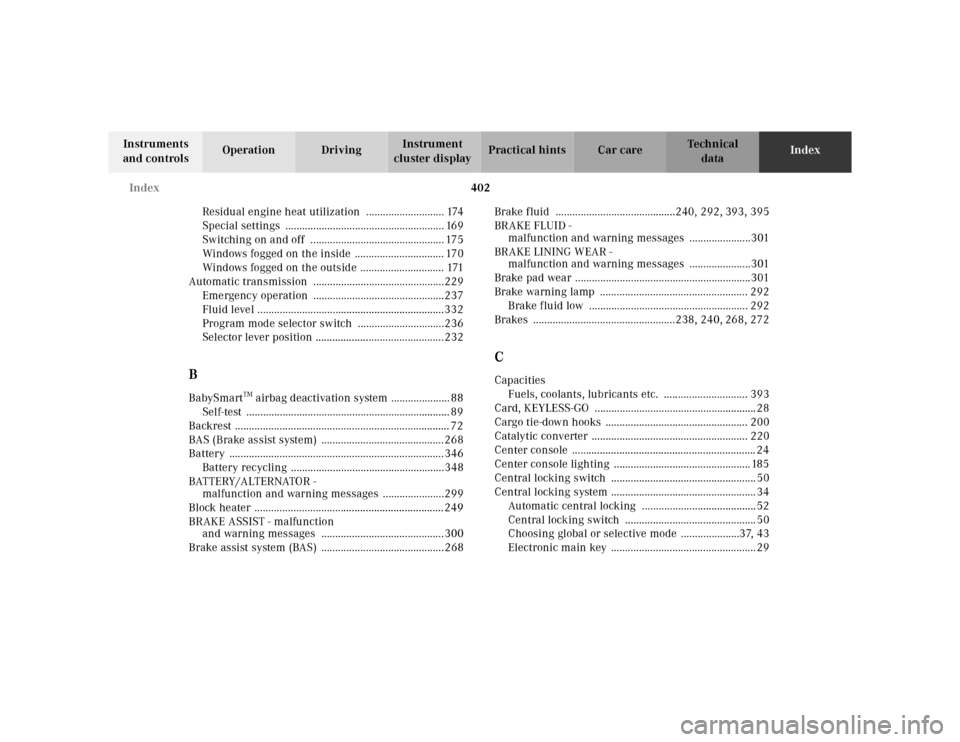
402 Index
Te ch n ica l
data Instruments
and controlsOperation DrivingInstrument
cluster displayPractical hints Car careIndex
Residual engine heat utilization ............................ 174
Special settings ......................................................... 169
Switching on and off ................................................ 175
Windows fogged on the inside ................................ 170
Windows fogged on the outside .............................. 171
Automatic transmission ...............................................229
Emergency operation ...............................................237
Fluid level ...................................................................332
Program mode selector switch ...............................236
Selector lever position ..............................................232
BBabySmart
TM airbag deactivation system ..................... 88
Self-test ......................................................................... 89
Backrest ............................................................................. 72
BAS (Brake assist system) ............................................268
Battery .............................................................................346
Battery recycling .......................................................348
BATTERY/ALTERNATOR -
malfunction and warning messages ......................299
Block heater ....................................................................249
BRAKE ASSIST - malfunction
and warning messages ............................................300
Brake assist system (BAS) ............................................268Brake fluid ...........................................240, 292, 393, 395
BRAKE FLUID -
malfunction and warning messages ......................301
BRAKE LINING WEAR -
malfunction and warning messages ......................301
Brake pad wear ...............................................................301
Brake warning lamp ..................................................... 292
Brake fluid low ......................................................... 292
Brakes ...................................................238, 240, 268, 272
CCapacities
Fuels, coolants, lubricants etc. .............................. 393
Card, KEYLESS-GO ..........................................................28
Cargo tie-down hooks ................................................... 200
Catalytic converter ........................................................ 220
Center console .................................................................. 24
Center console lighting ................................................. 185
Central locking switch .................................................... 50
Central locking system .................................................... 34
Automatic central locking .........................................52
Central locking switch ............................................... 50
Choosing global or selective mode .....................37, 43
Electronic main key .................................................... 29